Christine Donohoe gets a game-on gleam in her eye when a woman tells her they don’t like hospital food. “I say: ‘just give us a chance. If you don’t like it you can tell me when I go back to you.’ And I go back and they say: ‘No you’re right. It was lovely. I don’t know what I had in my head about hospital food.”
Most of us probably have the same low expectations. Hospital food means the smell of boiled veg or elderly deep fat fryer oil that haunts hospital corridors, shrivelled grey meals served when you’re feeling at your lowest.
Donohoe is a ward supervisor in Dublin's Rotunda hospital. She starts every shift talking to upwards of 100 women about what they'd like to eat, logging their choices on a tablet before heading back to the third floor heart of the kitchen operation.
If there was a TripAdvisor ranking for hospital food, the Rotunda would likely be top of the heap
The software tracks people as they move rapidly through a short pre or post natal stay. If one of her mothers is discharged before lunch the order will be deleted. If she moves ward her lunch will find her. Less food is wasted, and the compliments to the kitchen keep flowing.
Donohoe is approaching the end of her second decade as part of what her boss catering manager Deborah Cullen calls “the Rotunda family”. She wasn’t always convinced that hospital food could be ambitious. She still remembers the day a goats cheese tart was added to the menu. “Ah here,” she thought. But it got a surprisingly positive reaction.
If there was a TripAdvisor ranking for hospital food, the Rotunda would likely be top of the heap. There’s a spring in the step of the catering staff, not normally associated with lifers in the Irish health service. DJ Louise McSharry is partly responsible for it, after tweeting her delight earlier this year at how comforting she found the food.
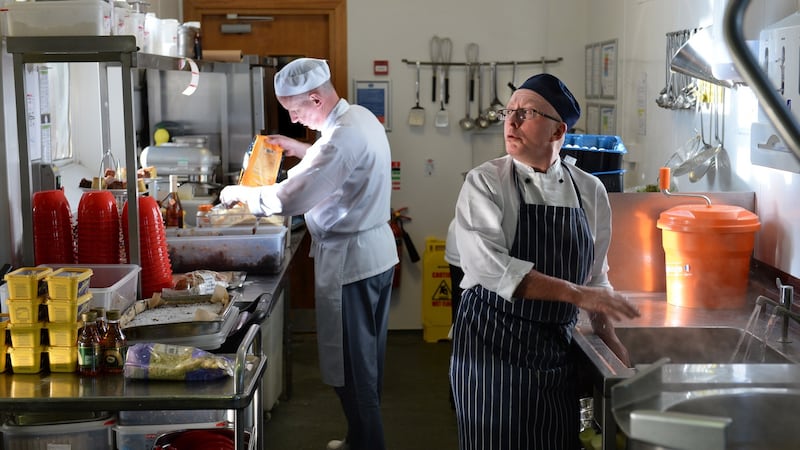
Cullen saw the reaction to the tweet in her office on the third floor of the hospital and “I said to Joyce [then executive chef Joyce Timmins] ‘why don’t we start taking photographs?’ Instead of taking photographs she said ‘I’m after taking a video.’ It went viral and it went from there.”
Rotunda food photographs became a thing. At the end of August when Timmins tweeted a shot of "ravioli tomato sauce, fresh rocket and Parmesan" and her "lasagne with side salad and garlic croute" chef and Irish Times food writer Paul Flynn replied: "That looks so good I'm going to try and get myself pregnant immediately."
Pastry chef Ian Carroll started his shift at 2am, mixing brandy and Guinness with fruit for a batch of nearly 50 Christmas puddings
So how do they do it and what could other hospitals and institutions learn? I’m here to lunch the easy way, without having had to give birth to anything more challenging than a pitch to an editor.
It’s 10am and this morning’s food service started eight hours earlier when pastry chef Ian Carroll started his shift at 2am, mixing brandy and Guinness with fruit for a batch of nearly 50 Christmas puddings, some of which will be sold to raise funds for the hospital.
He also rolled out several sets of fondant icing baby feet, pink for girls, blue for boys. These go on to the cup cakes he bakes for every new arrival. This morning there are five pink feet cupcakes and four blue ones, representing the newly minted people who came into the world in the last 20 or so hours.
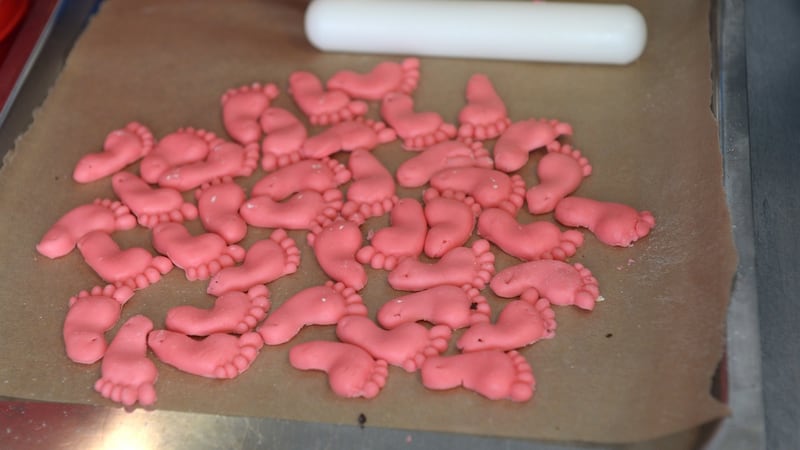
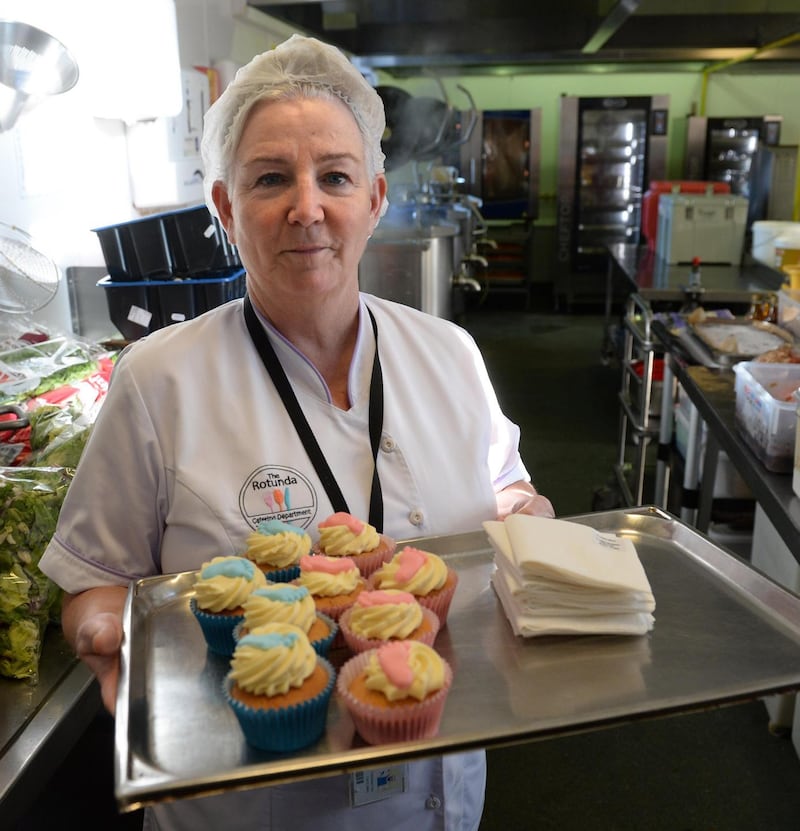
It’s a piece of baking that ends up in lots of parents’ WhatsApp and social media messages announcing the birth. “People think we buy them in in a box,” Carroll explains cheerfully. Most hospitals don’t have pastry chefs, he explains, “because they just buy everything in.”
He was working as a catering assistant serving meals on the wards until six years ago. The hospital’s annual birth figures are an easy way to keep track of how many fondant icing feet he’s made. “So I’ll probably do about 8,500 of them in a year.”
The "big game changer" here, came with the decision four years ago to establish satellite kitchens beside the wards
These human touches are what makes this venerable old building work, the people power that lubricates our clanking, sputtering health service like WD40.
The “big game changer” here, the Rotunda’s food catering manager Deborah Cullen explains, came with the decision four years ago to establish satellite kitchens beside the wards. This meant that meals could be plated minutes before they were served, so everything was as hot as it would be if it was being dished up in a home kitchen.
Cullen started as a grade two chef in the hospital nearly 17 years ago. “Her mammy left her here,” Donohoe jokes as we descend the stairs down to the staff restaurant in the basement.
Joyce Timmins has left the Rotunda to head up the kitchen in the Marymount Care Centre in Lucan, where she is applying her talent to serving food to dysphagia patients, or people who have difficulty swallowing. She says she has never had so much job satisfaction getting flavour, freshness and visual appeal into pureed food. The typical offering had been meat and veg mashed with gravy poured over it. One of her recent successes was a lamb tagine with cumin scented carrots, braised red cabbage and pureed chick peas, which received a resounding thumbs-up in the form of clean plates.
Success has many fathers, in this case mothers and fathers. A marriage of ideas and enthusiasm took place in the Rotunda, fuelled by the feedback of happy patients.
Timmins joined the staff as executive chef around two years after the move to plate the food beside the wards. Her philosophy was “fresh food that’s cooked for the time that it needs to be cooked,” she explains when I talk to her by phone before my visit to the Rotunda. So no overboiled vegetables. “They still have their colour and, more importantly, their nutrients.”
One of her first changes, Timmins says, was to get rid of pre-diced vegetables and get chefs chopping again because she “couldn’t stand battoned carrots”.
“Going back a good few years ago we would have got everything in unprepped,” Cullen explains. “Then we had a huge reduction in staff numbers so we had to go on to buying in some veg that was prepped.” That balance between ingredients and labour costs is where the sweet spot can be reached. “When Joyce came in she looked at how the food was presented and she worked with the chefs on how to get the best out of the visual look on the plate.”
Vegan patients have been particularly grateful not to have to exist purely on plates of “salad” as they must elsewhere. “Last week we had a vegan diabetic who sent us a lovely card, because anything she wanted we were able to do.”
The hospital is recruiting a new executive chef, but Cullen is adamant that it’s a team effort. This morning chef Somnath Khooseea is expertly chopping dried curry leaves to add to a Thai chicken curry sizzling on a large hot plate. The meat was marinated overnight in a paste he made from lemongrass, curry leaves, lime juice, coriander, ginger and garlic. The smell is delicious.
Is it more expensive to feed people like this? “We are not serving fillet steaks or very high-cost protein dishes,” Cullen explains. “If you look at our menu you’ll see that there’s a lot of pastas, there’s a lot of rices. There’s two vegetarian dishes on a day, so this brings down the cost.”
They choose cheaper cuts of meat, such as chicken thighs instead of fillets. The fresh fish they batter or bread in-house on a Friday “wouldn’t be a huge portion”. The budget per patient is about €5 to €6 a day, for all the meals, including an afternoon tea trolley – which is an interesting story in itself.
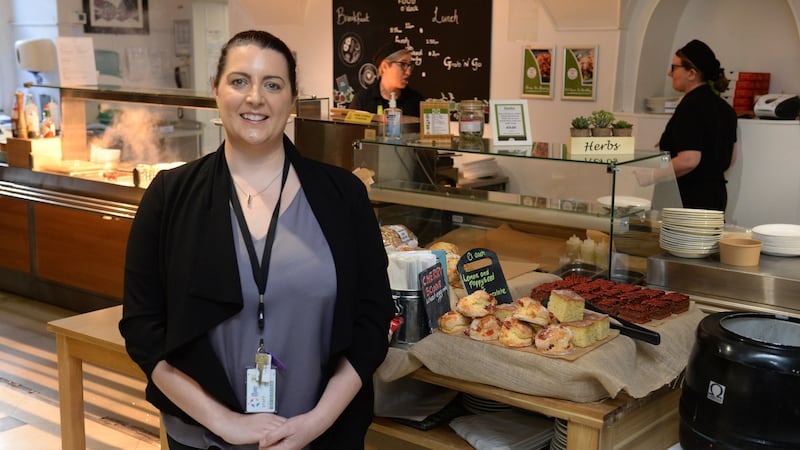
The trolley idea evolved after Cullen and other staff noticed lots of half-eaten plates coming back from lunch. Dessert was being served on the tray with the main course. “We spoke to patients and asked was there anything wrong. They said, ‘no we just couldn’t manage it. We were just too full.’
“So then we decided to take the dessert off the tray and offer an afternoon dessert service, with a yoghurt and fruit option alongside the sweeter pastries, so that totally reduced the waste because everyone could enjoy their main course. They had a bit of time to digest it.”
They also applied the trolley idea to breakfast to cut down on waste where orders were put in the night before and patients had gone home, moved beds or were “just not in the mood for having what they ordered.”
The kitchen caters for around 120 patients and the staff restaurant where they do around 300 covers a day. “We’ve noticed a huge increase in the staff numbers eating downstairs,” Cullen says. It’s where I eat the Thai red curry, garnished with fresh coriander, diced onions and chillis. It’s delicious and as good as anything you’d make at home.
'Remaking hospital menus isn't easy. Hospitals have to operate on strict budgets, and food supply is often outsourced'
So how can other hospitals up their food game? It’s clear that kitchen culture is a huge part of the Rotunda’s success, along with human labour (a nice irony given the day-to-day business of this maternity hospital). It’s down to cheffing skills rather than food preparation or the reheating of food service staples.
“We’re lucky we’re dealing with mainly well patients,” Cullen explains. “I know other hospitals the difficulty they have is they’re trying to cater for a number of different types of diets. But if you look at the basics I mean when you go to college as a chef you’re learning how to cook everything from scratch. You don’t learn how to cook packet stuff ...
“And it is a cheaper option at the end, with the ingredients. It is a small bit more labour intensive but the flavours are there, the nutrition is there and it’s much more beneficial.”
Chef Domini Kemp has been a long-time campaigner for better hospital food. "Remaking hospital menus isn't easy," she says. "Hospitals have to operate on strict budgets, and food supply is often outsourced to companies that specialise in high volumes of food at low cost."
The result is “packaged and processed foods that follow the food pyramid guidelines.” Kemp’s personal bugbear is the food pyramid – which puts highly processed cereals on a par with fresh unprocessed ingredients. She believes medical staff should have more respect for and training in nutrition and holistic ideas of food as medicine.
Endocrinologist Prof Francis Finucane is also concerned at the food messages Irish hospitals are giving out. “It does strike one that often for staff and patients in acute care settings it can be very difficult to make healthier food choices or healthier drink choices. The fact that unhealthy options would be available at all I, and many other health professionals, would consider undesirable.
“And if we can’t even get our act together in the institutions where we work it’s a sign of how complicated is in the wider domain.”
When Finucane looked into the idea of getting rid of vending machine junk food in his own hospital in Galway it turned out there were “contractual obligations that the HSE has that prevent that being changed.”
Does he eat well at work? “I would try to eat well at work. We have a good staff canteen. The thing is to try to make the healthier option easier in general to try to influence food choices for the better.”
The good the bad and the bewildering of hospital food as experienced by medical staff is summed up by one hospital doctor who’s been posted in many Irish hospitals in her years of training.
The Rotunda tops the doctor’s personal eating list, “it’s the dream in fairness,” she says, closely ranked along with St Francis Hospice in Blanchardstown not least because of its canteen setting, “ in a big open space with floor to ceiling views”.
Then there is the smaller rural hospital where “you’d sometimes be served up grey slop, some form of meat, ostensibly a curry or a stroganoff”, another where one day the salad had tinned peeled satsuma segments scattered through it, like a throwback to the 1970s.
There’s the major Dublin hospital “where I’m fairly sure they might only clean the deep fat fryers out once a month. It’s really grim. Anyone in the know goes straight to the salad bar.”
Is it difficult to eat healthily as a doctor? “You’re so busy you often don’t get time to eat. Canteen opening hours don’t line up with your working hours. The majority of people who work in hospitals aren’t doctors, and they do have regular hours so access to food can be really hit and miss.”
There is the Tupperware safety net of bringing a packed lunch but some hospitals don’t have staff lockers or fridges to facilitate that.
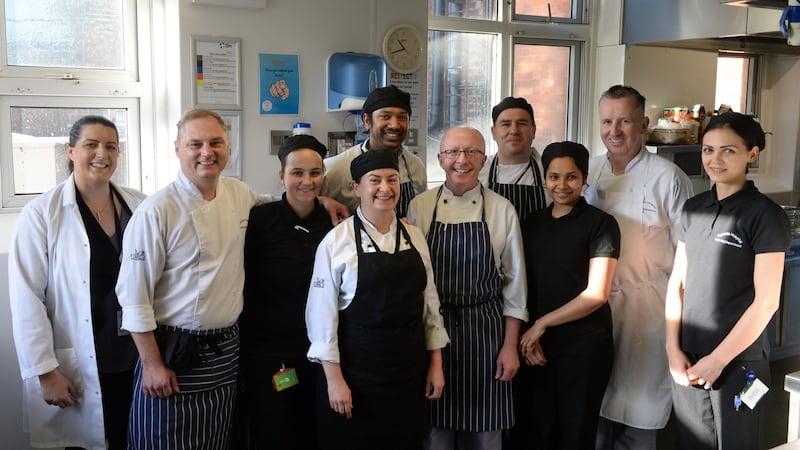
Nutritious food has such a positive effect on patients, the doctor says. Anaemia is a huge problem, and nutrition is growing as a major area of interest in the concept of recovery after surgery. “This was first championed by the gut surgeons and has expanded into gynie and obstetric surgery.” Patients recover better and “are happier when they get nice food.
“The catering staff are so absolutely adored in the Rotunda,” she says. “They take so much pride in what they do.” There were braised venison shanks and a wood pigeon starter served at one of the annual Charter Day dinners.
The Sunday roast is still the most popular meal of the week, Donohoe says. “I think it’s this old tradition of a Sunday dinner that’s still there.” She likes the sociability of her job as much as well as the positive energy of the place.
Donohoe gets to know many of the patients, some of them women who will go home to a house of small children or (in the case of homeless families), a hotel room where there’s no-one to let her rest, mind her baby or serve her up a roast dinner cooked from scratch. No one to mother her, like she’s mothered here.
Does Donohoe take a personal pride in changing people’s minds about hospital food? “Big time,” she says.











